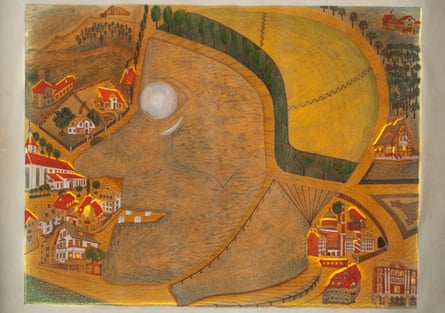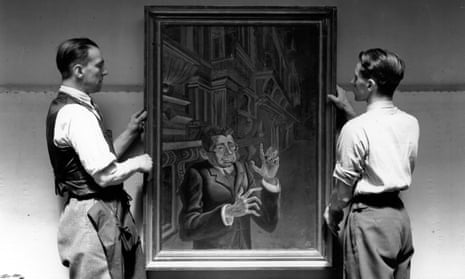On a winter’s day in 1898, a stocky young man with a handlebar moustache was hurrying along the banks of a canal in Hamburg, north Germany. Franz Karl Bühler was in a panic, fleeing a gang of mysterious agents who had been tormenting him for months. There was only one way to escape, he thought. He must swim for it. So he plunged into the dark water, close to freezing at this time of year, and struck out for the far side. When he was hauled on to the bank, soaked and shivering, it became clear to passersby that there was something odd about the man. There was no sign of his pursuers. He was confused, perhaps insane. So he was taken to the nearby Friedrichsberg “madhouse”, as it was known then, and taken inside. He would remain in the dubious care of the German psychiatric system for the next 42 years, one of hundreds of thousands of patients who lived near-invisible lives behind the asylum walls.
Bühler’s incarceration disturbed him, but it also marked the beginning of a remarkable story, one in which he played a leading role. It reveals the debt art owes to mental illness, and the way that connection was used to wage history’s most destructive culture war.
Bühler was diagnosed with schizophrenia, and as he was moved from one psychiatric clinic to another, he devised a way to cope with his situation: he would teach himself to draw. He began by sketching the people around him, documenting the pointless repetitive activities of institutionalised life. Later he produced searing self-portraits and garish creatures from his psychotic visions: demonic dogs and death-angels. His doctors didn’t much care for his art – if, indeed, a “madman” could create art at all – and many of his sketches languished in his case file for two decades, until an important visitor arrived from Heidelberg.
Hans Prinzhorn was a qualified physician, a doctor of art history, a decorated soldier and a professionally trained baritone. But it was his work on the art of the insane, conducted at Heidelberg university psychiatric clinic, that would stand as his greatest achievement. Between 1919 and 1921, he amassed the world’s most significant collection of psychiatric art, thousands of pieces of every type, executed with every available variety of media – toilet paper, discarded rotas, wooden parts of asylum beds – by hundreds of inpatients. Diagnosed mostly with schizophrenia, these individuals didn’t always intend to make “art”. They used sketches, sculpture and writing to chart aspects of their psychotic reality, or to communicate messages from an isolated interior. The initial idea was that this material might help with diagnosis, but Prinzhorn soon realised its expressionistic power and artistic value.

Visitors would remark that it “opened windows on a different reality”, or that it was as if it had “bubbled up from the depths of the human psyche”. “Remarkable worlds opened up before me,” one future curator of the collection would write, “drew me into their power; open spaces took away my equilibrium and made me dizzy.” In 1922, Prinzhorn published his conclusions about the project in a groundbreaking volume, Artistry of the Mentally Ill, heavily illustrated with images from the collection. His greatest find, the pick of his “schizophrenic masters”, was Bühler.
Artistry became an instant hit with the avant garde, who at that time were exploring madness as a way to understand the horror they had experienced during the first world war. As the dadaist Hans Arp put it, “Repelled by the slaughterhouses of the world war, we turned to art.” For Hugo Ball, the co-founder of Dada, Prinzhorn’s book represented nothing less than “the turning point of two epochs”.
When Max Ernst took a copy of the book to Paris, it rapidly became an essential source for members of the new surrealist movement, including Ernst and Salvador Dalí. At last, the surrealist-in-chief André Breton wrote, someone had given insane artists a “presentation worthy of their talents”.
Madness had never been in such vogue. But the Heidelberg works were never less than controversial, and by the mid-1920s, art’s connection with insanity had come to the attention of the extreme right.
Adolf Hitler was, like Bühler, a self-taught artist. He was also, according to a psychologist who examined him in 1923, “a morbid psychopath … prone to hysteria”. After failing the entrance exam for the Academy of Fine Arts in Vienna, he had scraped a living by copying tourist postcards in watercolours. When war broke out in 1914, he took his brushes and paints to the front, and when he moved into politics after the war, he took his art with him.
Art helped him create a Nazi aesthetic, in the party emblems, badges and uniforms he designed, the stage sets he oversaw and the propaganda he sponsored. Art also gave Hitler a higher political purpose. Wars came and went, he liked to say, but in millennia to come the Germans would be judged on their cultural achievements, just as the great civilizations of the past were judged on theirs. To restore German culture was to restore the “ethnically pure” German Volk; to see it decline was to witness the Volk’s decline. And the insane direction contemporary art was taking marked, for him, a decline of epic proportions.

There is no proof that Hitler read Prinzhorn’s book, but he would have been exposed to its ideas through newspapers and magazines, and it could well have served as a catalyst for his views. In Mein Kampf he railed against “half-wits” and “scoundrels” who tried to stultify the “healthy artistic feeling” of the high Romantic painters he loved. Modernist “nonsense” and “obviously crazy” stuff was a cynical ploy to stave off criticism by horrified fellow citizens, while movements such as cubism and dadaism were “the morbid excrescences of insane and degenerate men”. As early as 1920, the party manifesto called for a struggle against the “tendencies in the arts and literature which exercise a disintegrating influence on the life of the people”. After 1933, that is what they did.
It was Goebbels’ idea, in 1937, to stage the Degenerate Art show. With 3 million visitors, this touring exhibition remains the best attended of all time, but it didn’t celebrate art; it pilloried it. From the second leg, in Berlin, the propaganda directorate rifled the Heidelberg clinic for more than 100 works, including several by Bühler, and displayed a selection of these alongside the professional art. The idea, as the official guidebook stated, was to show that the avant garde were even more “sick” than real “lunatics”. This was held up as evidence of the great Jewish-Bolshevik conspiracy aimed at undermining German culture and polluting the race with inferior blood. Cultural degeneration, the “slowly rotting world”, as Hitler put it, prefigured biological degeneration, which was hastening the Germans “towards the abyss”.
The solution was simple: a “relentless war of cultural cleansing”. Modern art was removed from German museums, to be sold off or simply destroyed, and “degenerate” artists were hounded out of the country. But Hitler’s most ambitious artistic project, his Gesamtkunstwerk, was to refashion Germans themselves. To this end, in 1939 he ordered the first Nazi mass-murder programme, Aktion T4, targeting the mentally ill.
In 1940, Bühler was living in an asylum at Emmendingen, in Baden-Württemberg. On 5 March that year, a small convoy of vehicles arrived at the institution, staffed by SS men in civilian clothes. They loaded 50 patients on to the buses, including Bühler, and drove them to a specially adapted home for disabled people at Grafeneck castle, in Swabia. The patients were stripped and pushed into a gas chamber disguised as a shower room, and killed with carbon monoxide. This “euthanasia” action, as the Nazis called it, is widely seen as a precursor to the Holocaust, and when it had achieved its targets, many of Aktion T4’s hardened veterans were reassigned to extermination camps in the east. By the war’s end, about 200,000 psychiatric patients would be killed by Hitler’s regime, including 30 Prinzhorn artists.
The war did not mark the end for Prinzhorn’s collection. Miraculously, most of the works survived, and inspired new generations of artists, including Jean Dubuffet, the creator of art brut (“raw art”). Bühler was murdered, as were other Prinzhorn artists, but his achievements live on. They broadened the definition of art, and expanded the circle of permitted art-makers beyond the elite.
